Chemical Effects of Electric current Class 8 Important Questions and Answers
Important questions of Class 8 Science Chapter 14 Chemical Effects of Electric current is given below. These important questions will help students while preparing for the exam. Practising these important questions will analyse their performance and work on their weak points. Score well in exam of Class 8 Science by going through these important questions. Students of Class 8 can download important questions of Class 8 Science Chapter 14 Chemical Effects of Electric current PDF by clicking the link provided below.
Important Questions of Class 8 Science Chapter 14 Chemical Effects of Electric current
Here you can get Class 8 Important Questions Science based on NCERT Text book for Class 8. Science Class 8 Important Questions are very helpful to score high marks in board exams. Here we have covered Important Questions on Chemical Effects of Electric current for Class 8 Science subject.
Very Short Answer Questions
1. What is electricity?
Answer: Electricity is a phenomenon known for its effect like chemical effect, Heating effect and magnetic effect.
2. What is the cause of electricity?
Answer: The flow of charge is the main cause of electricity.
3. What is charge?
Answer: The fundamental properties of matter caused by gain or loss of electrons.SI unit of charge is Coulomb or C
4. What is the charge on 1 electron?
Answer: 1.6 × 10-19C
5. What are the two types of electricity on the basis of charge?
Answer: The two types of electricity on the basis of charge are:
(a) Static electricity: The electricity cause by the charge at rest.
(b) Current electricity: The electricity cause by the charge when in motion
6. What is the cause of the flow of charge?
Answer: Electric potential or potential difference is the main cause of electric charge.
7. What do you mean by chemical effect of current?
Answer: The phenomenon of causing chemical change by passing electric current through a conduction solution is called chemical effect of current. For example: Electrolysis and Electroplating
8. What do you mean by heating effect of current?
Answer: Whenever current flows through a conductor it causes heating of material. This effect of current is known as heating effect of current.
9. What do you mean by magnetic effect of current?
Answer: Whenever current flows through a conductor it behaves like a magnet. This effect of current is known as magnetic effect of current.
10. What is LED?
Answer: LED stands for Light Emitting Diode. LED glows even when a weak electric current flows through it.
11. What precaution you should take to add LED in a circuit?
Answer: The longer lead is always connected to the positive terminal of the battery and the shorter lead is connected to the negative terminal of the battery.
12. What are good conductors?
Answer: The materials which allow electric current to pass through them are called good conductors of the electricity.
13. Give two examples of good conductors of electricity.
Answer: Copper, iron.
14. Why is it dangerous to touch an electrical appliance with wet hands?
Answer: Wet hands act as good conductors. So we feel electric shocks when we touch electric appliance with wet hands.
15. What are insulators (poor conductors) of electricity?
Answer: The materials which do not allow electric current to pass through them are called poor conductors.
16. Give two examples of poor conductors of electricity.
Answer: Dry wood, rubber.
17. What is electric current?
Answer: The flow of charges (electricity) is called electric current.
18. Do liquids conduct electricity?
Answer: Yes, liquids also conduct electricity.
19. How can you check current?
Answer: We check current by using tester.
20. Give any liquid conductor.
Answer: Tap water.
21. Can distilled water conduct electricity?
Answer: No, distilled water cannot conduct electricity.
22. How can we test that liquids conduct electricity?
Answer: We use tester to check that the liquids conduct electricity.
23. Name some substances which make the liquids good conductor of electricity.
Answer: Acids, Bases and Salts.
24. Name two liquid substances other than water which conduct electricity.
Answer: (i) Lemon Juice (ii) Vinegar.
25. Sometimes even though the liquid is conducting, the bulb may not glow. Give reason.
Answer: Sometimes the bulb does not glow because the current through it is too weak to make the bulb glow.
26. Which effect of current causes the bulb to glow?
Answer: Heating effect.
27. Name the part of bulb which glows.
Answer: Filament.
28. What is LED?
Answer: LED is a device or bulb which glows even at low or small current.
29. Write full form of LED.
Answer: Light Emitting Diode.
30. What are the three effects of electric current?
Answer: There are three effects of electric current—heating, magnetic and the chemical effect.
31. What is magnetic effect of electric current?
Answer: The electric current also produces the magnetic effect by which a current carrying wire behaves like a magnet.
32. What happens when a compass needle is brought near a wire in which current is flowing?
Answer: The needle deflects.
33. How can we check magnetic effects of current?
Answer: By using magnetic compass.
34. Does distilled water conduct electricity?
Answer: No, distilled water does not conduct electricity.
35. How can we make distilled water a good conductor of electricity?
Answer: By adding some salt in distilled water.
36. What is distilled water?
Answer: The water which is free of salts is called distilled water.
37. Name a salt which makes distilled water a good conductor of electricity.
Answer: Common salt.
38. What are electrodes?
Answer: The metal rods dipped in liquids to which cells are attached are called electrodes.
39. Name the gases which release when current is passed through water.
Answer: Hydrogen and oxygen.
40. Name the gas deposited on negative electrode.
Answer: Hydrogen.
41. Name the gas deposited on a positively charged electrode.
Answer: Oxygen.
42. Name the process that shows the chemical effect of electricity.
Answer: Electroplating.
43. Define electroplating.
Answer: The coating of a layer of desired metal on other metallic surface by passing electric current is called electroplating.
44. Is air a conductor or an insulator?
Answer: Insulator.
Short Answer Type Questions
1: Differentiate between good conductors and bad conductors of electricity.
Answer:
| Good conductors of electricity | Bad conductors of electricity |
| They allow electricity to pass through it | They do not allow electricity to pass through it |
| Metals are generally good conductors | Non- Metals are generally bad conductors |
| Eg: copper, aluminium | Eg: rubber, wood |
2: Describe an electrical tester.
Answer: An electrical tester is a simple piece of electronic test equipment used to determine the presence or absence of an electric voltage in a piece of equipment under test. It is also used to test whether a liquid allows electric current to pass through it or not.
3: How can we check whether a tester is working or not?
Answer: Join the free ends of the tester together, for a moment, and check whether the bulb glows or not, if the bulb glows it means tester is working and if not it means tester is not working. In case it does not glow check that all connections are tight, or not.
4: How can you test whether lemon juice is good conductor or poor conductor of electricity?
Answer: Pour one table spoon of lemon juice in a plastic cap of discarded bottle, dip the end of tester into lemon juice, make sure that the tester should not more than 1 cm apart at also should not touch each other, we will observe the current flows in the circuit and bulb glows, this proves that lemon juice is good conductor.
5: In some situation even liquid is allowing the electric current to pass but, bulb does not glow. Why so?
Answer: This happens when current through the circuit is too weak to make the bulb glow.
6: Why the filament of bulb does not get heated sometimes in a circuit?
Answer: This is because current through the circuit is too weak so the filament of the bulb does not get heated sufficiently and it does not glow.
7: Is it possible for an electric tester to detect weak current also, if no how can we detect weak current flowing in a circuit?
Answer: If weak current flows through the circuit then bulb in it will not glow. In order to detect weak current we use LED or may use another effect of electric current that is it produces magnetic effect also so we can use this property of electric current to detect weak current.
8: Why materials classified as poor conductors, also allow electricity to pass under certain conditions?
Answer: Under certain condition most of the materials can conduct electricity thus it is right to say poor conductors instead of bad conductors or insulators.
9: Distilled water is good conductor or bad, how can we make distilled water a good conductor?
Answer: Distilled water is a poor conductor but if we add some salt in it the resulting salt solution is good conductor.
10: Explain the functioning of a LED.
Answer: LED stands for Light emitting diode. It is a semiconductor light source, use to detect weak current in the circuit. There are two wires attached to a LED, one lead is slightly longer than the another one, the longer lead is always connected to the positive terminal of battery and shorter lead is connected to negative terminal of battery
11: What are the purpose of one longer and another shorter lead of a LED?
Answer: the longer lead is always connected to the positive terminal of battery and shorter lead is connected to negative terminal of battery.
12: Why tap water is always good conductors?
Answer: Tap water is not pure, it contains several amounts of mineral salts naturally dissolved in it, thus it is a good conductor.
13: Why water that we get from ponds and hand pumps are always good conductors?
Answer: Water that we get from ponds and hand pumps is not pure, it contains several amounts of mineral salts naturally dissolved in it , thus it is good conductor.
14: We add small amount of dilute hydrochloric acid to distilled water, the resulting solution will be a good conductor or poor conductor? Explain why.
Answer: Good conductor, because when we add kitchen salt (NaCl) to the distilled water the salt dissolves in water by splitting its molecules in ions:
H2O + NaCl→ H2O + (Na+) + (Cl–)
The NaCl molecules react to give ions. This happens because the NaCl is a strong electrolyte. Solutions of strong electrolytes are good conductors of electricity because they contain a relatively high concentration of ions.
15: We add small amount of sugar to distilled water, the resulting solution will be a good conductor or poor conductor? Explain why.
Answer: Poor conductor, because Sugar, as a non-electrolyte substance, does not produce ions when dissolved in water. A solution of sugar contains molecules of sucrose, but no ions. The absence of ions in a sugar aqueous solution makes it a non-electricity conductor fluid.
16: What happens when electrodes are immersed in water and a current is passed?
Answer: When electrodes are immersed in water and a current is passed bubbles of oxygen and hydrogen is produced.
17: What do you mean by gold plating?
Answer: Gold plating is one of the most common applications of electroplating in ornament-making.
18: Define electro- magnetic induction.
Answer: In a circuit the induced current flowing through the coil is always such that it opposes the motion of the magnet. This process of producing induced current due to a varying magnetic field is called electro- magnetic induction.
19: What do you mean by electrolysis and electrolytes?
Answer: Electrolysis: The passage of an electric current through a liquid causes chemical changes. This process is known as electrolysis.
Electrolytes: Conduction is possible only in those liquids which are at least partly dissociated into oppositely charged ions; such liquids are called electrolytes. Solutions of many inorganic chemical compounds (e.g. common salt, sulphuric acid, etc.) are examples of this type of liquid.
20: What do you mean by voltameter?
Answer: Voltameter: In electrolysis, the whole arrangement of electrodes, electrolyte and the vessel containing them is called a voltameter. In the case of the copper voltameter, which involves copper electrodes in copper sulphate solution, the net effect is that copper is dissolved off the anode and deposited on the cathode, with the electrolyte remaining unchanged.
21: When the free ends of a tester are dipped into a solution, the magnetic needle shows deflection. Can you explain why?
Answer: The deflection through the compass needle shows that current is flowing through the wounded wire and hence through the circuit. The circuit is complete since free ends of the tester are dipped in the solution and the solution is certainly conducting solution.
22: In case of fire before the fireman used the water hoses, they shut off the main electrical supply of the area, why so?
Answer: Water may conduct electricity, if the electrical supply of the area is not shut off and water is poured over electrical appliances then electricity may pass through fire and may harm the fireman, thus In case of fire before the fireman used the water hoses, they shut off the main electrical supply of the area
23: In which case the compass needle will deflect more: by testing sea water or by testing drinking water?
Answer: The compass needle will defect more in case of sea water than drinking water because sea water contains more dissolved salt than the drinking water.
24: It is said that rain water is as pure as distilled water, but once while testing rain water compass needle shows deflection, explain why?
Answer: This is because rain water contains dissolved salts that makes it a conducting solution.
26: Differentiate between conductors and insulators.
Answer: The substances which allow the electric current to pass through them are called conductors. Example metals like copper, aluminium. The substances which do not allow electric current to pass through them are called insulators, example : rubber, wood
27: Write some of the chemical effects of electric current. What causes the chemical reactions in a conducting solution?
Answer: The passage of an electric current through a conducting solution causes chemical reactions. Following are listed some of the chemical effects of electric current:
- Bubbles of a gas may be formed on the electrodes.
- Deposits of metal may be seen on electrodes.
- Changes of colour of solutions may occur.
- In fact, the reaction would depend on what solution and electrodes are used.
28: Is it safe for an electrician to carry out electrical repairs outdoors during heavy downpour? Explain.
Answer: No, it is not at all safe for an electrician to carry out electrical repairs during heavy downpour. Rather, it is highly dangerous, because during heavy downpour there is a high risk of electrocution.
29: What do you mean by electric current?
Answer: The continuous and directional flow of charges (electrons) is called electric current. It is denoted by I and its unit is ampere.
30: What is a tester?
Answer: The instrument which is used to check the flow of electric current is called tester. It is attached to the terminals of the electric circuit. If the bulb of tester glows, it confirms that current is flowing through the circuit.
31: How can you test whether the liquids conduct or do not conduct the electricity?
Answer: Some liquids are the good conductors of electricity while some are poor conductors. The liquids can be tested for conductor of electricity. The free ends of a tester are dipped in liquid to be tested and then observe the bulb, if it glows, it confirms that the liquid is good conductor otherwise liquid is a poor conductor.
32: Show that lemon juice and vinegar are good conductors of electricity.
Answer: Collect a few plastic or rubber caps of bottles. Pour one teaspoon of lemon juice or vinegar in one cap. Bring the tester over the cap and let the ends of the tester dip into lemon juice or vinegar. We see that bulb starts to glow. It indicates that lemon juice and vinegar are good conductors of electricity.
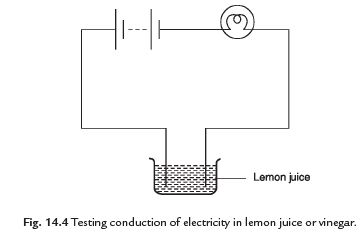
33: Explain the mechanism of glowing of bulb in liquid.
Answer: When the liquid between the two ends of a tester allows the electric current to pass, the circuit of the tester becomes complete. The current flows in the liquid circuit and the bulb glows. When the liquid does not allow the electric current to pass, the circuit of the tester is not complete and the bulb does not glow.
34: There are some situations in which even though liquid is conducting, bulb may not glow. Give reasons.
Answer: The possible reasons may be:
(i) The current may be weak.
(ii) Bulb may be fused.
(iii) Incomplete circuit.
35: Explain why a bulb glows on passing current.
Answer: When the current passes through a bulb, the filament of the bulb gets heated to a high temperature due to the heating effect of current. The bulb starts to glow. Sometimes the current is too weak and filament does not get heated sufficiently and bulb does not glow.
36: What is LED? Why is it most important source of light?
Answer: The device which is used in the tester in place of bulb is called LED. It glows even at very small current. There are two wires called leads attached to the LED. One lead is longer than the other. A long wire is connected with the positive terminal and shorter lead is connected to the negative terminal of battery.
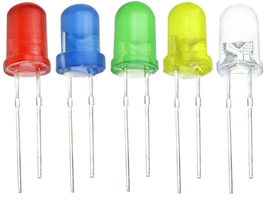
37: What do you mean by magnetic effect of electricity?
Answer: When electric current is passed through a coil or wire, then it behaves like a magnet. This is called magnetic effect of current. The strength of magnetic field depends on the amount of current passing through a coil or wire. The coil or wire shows magnetism till current is passed.
38: The ordinary water can conduct electricity while distilled water does not. Explain why.
Answer: The water that we get from various sources like taps, hand pumps, wells and ponds is not pure. It may contain several salts dissolved in it. This water is thus good conductor of electricity. Distilled water is free of salts due to which it is a poor conductor.
39: Why do we need magnetic compass to test the conduction of electric current?
Answer: Sometimes the bulb does not glow on passing electric current. This is because the electric current flowing through a conductor is so small, that the filament of the bulb does not get heated up to the temperature where it starts glowing. So, in case of small current we need magnetic compass to test the conduction.
40: What is chemical effect of electricity? Give some examples of chemical effects.
Answer: The process in which a chemical reaction or change takes place in a solution on passing electricity is called chemical effect of electricity.
The passage of an electric current through a conducting solution causes chemical reactions. For example, change in colour of solutions and electroplating.
Long Answer Type Questions
1: Explain the process of electroplating, along with its advantages and uses.
Answer: One of the most common applications of the chemical effect of electric current is electroplating. In this process, there exists a liquid, usually called the electrolyte, through which current passes. Two electrodes, connected to the terminals of a battery with a switch in between, are inserted in the liquid. The electrode that is connected to the positive terminal of the battery is called the “anode,” and the other connected to the negative terminal is called the “cathode”. Electroplating is done in industries to have an anti-reactive coating on the parts of machines so that they do not react with the raw material, to have an anti-corrosive coating for the machines so that they do not get corroded, and a heat-resistive coating for parts like boilers to resist the heat produced by the machinery. The process of electroplating is used for plating parts of vehicles with nickel and chromium, which protects them from corrosion.
2: Most liquids that conduct electricity are solutions of acid, bases and salt . Justify the statement.
Answer: Good conductor, because When we add kitchen salt (NaCl) to the distilled water the salt dissolves in water by splitting its molecules in ions:
H2O + NaCl → H2O + (Na+) + (Cl-)
The NaCl molecules react to give ions. This happens because the NaCl is a strong electrolyte. Solutions of strong electrolytes are good conductors of electricity because they contain a relatively high concentration of ions.
Poor conductor, because Sugar, as a non-electrolyte substance, does not produce ions when dissolved in water. A solution of sugar contains molecules of sucrose, but no ions. The absence of ions in a sugar aqueous solution makes it a non-electricity conductor fluid.
3: Prepare a tester to test conduction based on magnetic effect of the electricity.
Answer: Take the tray of a discarded matchbox. Wrap an electric wire a few times around the tray. Place a small compass needle inside it. Now connect one free end of the wire to the terminal of a battery. Leave the other end free. Take another piece of wire and connect it to the terminal of battery. Join the free ends of two wires momentarily. The compass needle should show deflection. The tester with two free ends of wire is ready.
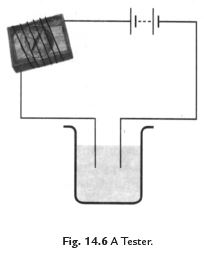
4: Complete the following table and classify the liquids by using tester.
| Material | Compass needle shows deflection (Yes/No) | Conductor/Insulator |
| Lemon juice | Yes | Conductor |
| Vinegar | ||
| Tap water | ||
| Vegetable oil | ||
| Milk | ||
| Honey |
Answer:
| Material | Compass needle shows deflection (Yes/No) | Conductor/Insulator |
| Lemon juice | Yes | Conductor |
| Vinegar | Yes | Conductor |
| Tap water | Yes | Conductor |
| Vegetable oil | No | Insulator |
| Milk | No | Insulator |
| Honey | No | Insulator |
5: What are the two methods of testing an insulator or a conductor?
Answer: The following two methods are used to test the conduction.
(i) We use an electric lamp to test conductivity. An electric lamp is attached to the electric circuit. If the substance allows the current to pass through it, the bulb will start glowing. Otherwise, the bulb will not glow. This method does not work when current is very small. In such cases magnetic compass is used.
(ii) A magnetic tester is used to test conductivity when current is allowed to pass through it, it creates a magnetic field and the compass shows deflection. The deflection of compass shows that the current is passing through circuit (See Fig.).
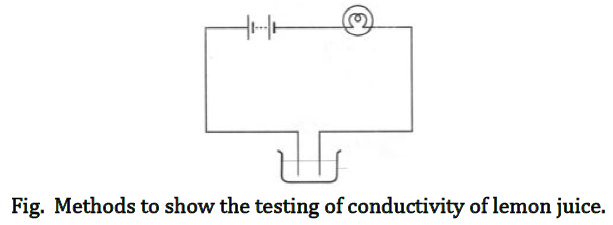
6: What do you mean by electroplating? How does it take place?
Answer: The process of coating a desired metal on other metal surface by using electric current is called electroplating.
A metal plate and the substance to be coated are dipped in a current conducting solution with conducting wires. The object to be coated is attached to the negative terminal. When electric current is passed through the solution, the compounds of the conducting solution start breaking. The free metallic particles get deposited on the object at negative terminal of the battery. In this way we can get a coating of desired metal on any object by preparing suitable conducting solution and by using suitable electrodes.
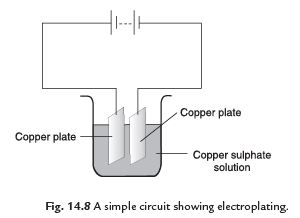
7: Explain the advantages of electroplating.
Answer: The advantages of electroplating:
(i) It is used to coat a desired metal on other objects.
(ii) It protects the metals from corrosion.
(iii) It also prevents the metallic surfaces from rusting.
(iv) Some cheap and dull metals are coated with costly and shiny metals.
(v) It can make more reactive metals like iron, less reactive.
(vi) Coating of chromium on metals give lustre to objects.
8: Explain the process of electroplating.
Answer: One of the most common applications of the chemical effect of electric current is electroplating. In this process, there exists a liquid, usually called the electrolyte, through which current passes. Two electrodes, connected to the terminals of a battery with a switch in between, are inserted in the liquid. The electrode that is connected to the positive terminal of the battery is called the “anode,” and the other connected to the negative terminal is called the “cathode”. Electroplating is done in industries to have an anti-reactive coating on the parts of machines so that they do not react with the raw material, to have an anti-corrosive coating for the machines so that they do not get corroded, and a heat-resistive coating for parts like boilers to resist the heat produced by the machinery. The process of electroplating is used for plating parts of vehicles with nickel and chromium, which protects them from corrosion.
9: Can you prepare an electric pen? Describe how?
Answer: Take a filter paper and soak it with potassium iodide and starch solution.
- Spread this filter paper on a metal sheet.
- Now take two connecting wires and join them to the terminals of battery.
- Attach the wire connected at positive end to plate.
- Now write on the sheet wire attached to negative terminal.
We will see that wherever we write, blue coloured ink will appear. The reason for this is electrolysis of potassium iodide solution which produces iodine. Iodine on reaction with starch produces ink of blue colour.